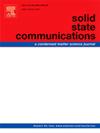Nanostructured designs for extreme strain hardening of metallic glasses
IF 2.4
4区 物理与天体物理
Q3 PHYSICS, CONDENSED MATTER
引用次数: 0
Abstract
The absence of ductility has historically limited the practical applications of metallic glasses. Despite extensive research over many years, a sophisticated and effective solution remains elusive. Inspired by the design of fractal nanostructures, we propose an enhanced nanostructure design method that effectively mitigates the complexity of engineering applications. Through simulation studies, we demonstrate that by optimizing nanostructures, metallic glasses exhibit substantial tensile ductility and strain hardening. This enhancement is attributed to the synergistic effect of multiple nanobranches, which collectively contribute to the deformation process, impeding the formation of shear bands and inducing homogeneous deformation of the metallic glass, thereby altering its conventional deformation mode. To achieve enhanced plasticity and substantial strain hardening, it is essential to maintain a low overall connectivity of the nanostructured metallic glass, thereby preventing the formation of shear bands throughout the sample.
金属玻璃极端应变硬化的纳米结构设计
缺乏延展性历来限制了金属玻璃的实际应用。尽管多年来进行了广泛的研究,但仍然难以找到复杂而有效的解决方案。受分形纳米结构设计的启发,我们提出了一种改进的纳米结构设计方法,有效地降低了工程应用的复杂性。通过模拟研究,我们证明通过优化纳米结构,金属玻璃具有良好的拉伸延展性和应变硬化性。这种增强是由于多个纳米分支的协同作用,它们共同促进了变形过程,阻碍了剪切带的形成,诱导了金属玻璃的均匀变形,从而改变了其传统的变形模式。为了获得增强的塑性和实质性的应变硬化,必须保持纳米结构金属玻璃的低整体连通性,从而防止在整个样品中形成剪切带。
本文章由计算机程序翻译,如有差异,请以英文原文为准。
求助全文
约1分钟内获得全文
求助全文
来源期刊

Solid State Communications
物理-物理:凝聚态物理
CiteScore
3.40
自引率
4.80%
发文量
287
审稿时长
51 days
期刊介绍:
Solid State Communications is an international medium for the publication of short communications and original research articles on significant developments in condensed matter science, giving scientists immediate access to important, recently completed work. The journal publishes original experimental and theoretical research on the physical and chemical properties of solids and other condensed systems and also on their preparation. The submission of manuscripts reporting research on the basic physics of materials science and devices, as well as of state-of-the-art microstructures and nanostructures, is encouraged.
A coherent quantitative treatment emphasizing new physics is expected rather than a simple accumulation of experimental data. Consistent with these aims, the short communications should be kept concise and short, usually not longer than six printed pages. The number of figures and tables should also be kept to a minimum. Solid State Communications now also welcomes original research articles without length restrictions.
The Fast-Track section of Solid State Communications is the venue for very rapid publication of short communications on significant developments in condensed matter science. The goal is to offer the broad condensed matter community quick and immediate access to publish recently completed papers in research areas that are rapidly evolving and in which there are developments with great potential impact.
 求助内容:
求助内容: 应助结果提醒方式:
应助结果提醒方式:


